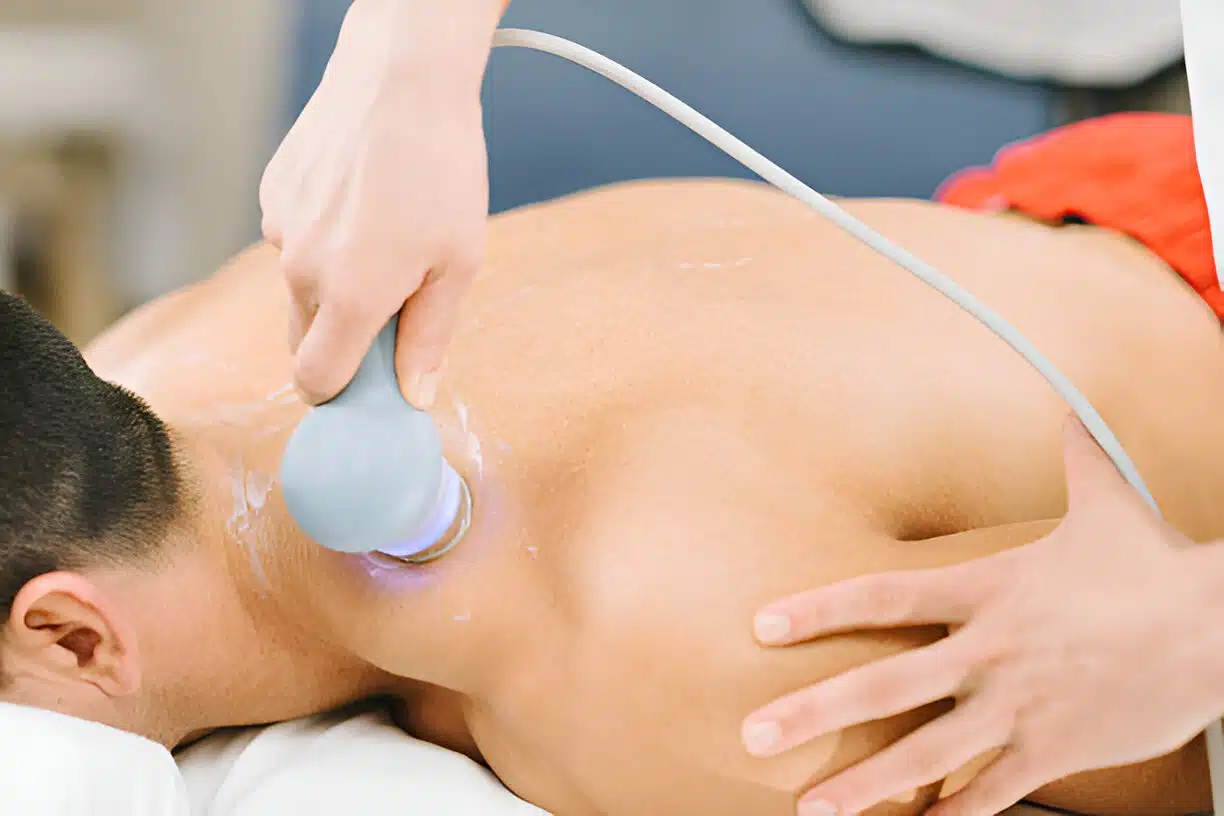
Struggling with muscle pain, joint stiffness, or slow-healing injuries? Ultrasound therapy is a non-invasive treatment that uses sound waves to promote deep tissue healing, reduce inflammation, and relieve pain. Whether you're recovering from an injury or managing a chronic condition, this therapy can enhance your recovery and improve mobility.
Ultrasound therapy works by delivering high-frequency sound waves into the affected area, generating gentle heat that increases blood flow, reduces muscle spasms, and accelerates tissue repair. It is commonly used to treat conditions such as tendonitis, bursitis, ligament injuries, and chronic pain syndromes. This therapy can also help break down scar tissue and improve flexibility, making it a great option for rehabilitation and pain management.
If you're looking for a safe, effective way to support healing and reduce pain, ultrasound therapy may be the right choice. A customized treatment plan can help you regain mobility and feel your best. At Washington Wellness Center in Robbinsville Township, NJ, we offer customized treatment plans to help you regain mobility and feel your best. By filling out your patient forms, we can guarantee a seamless and efficient visit for you.





At Washington Wellness Center, our Ultrasound Therapy service is designed to enhance your recovery and overall well-being. This innovative treatment utilizes sound waves to penetrate deep into tissues, promoting increased blood flow, reducing inflammation, and alleviating pain. Whether you're healing from an injury, managing chronic discomfort, or seeking to enhance mobility, our trained professionals customize each session to address your specific needs. With a focus on holistic healing, we strive to provide a comfortable and supportive environment where you can experience the numerous benefits of Ultrasound Therapy, helping you get back to doing what you love. Our chiropractors accept most insurance plans, making these treatments more accessible to individuals seeking holistic care.
Therapeutic ultrasound has become an integral modality in injury recovery, particularly in the realm of musculoskeletal issues. By utilizing sound waves at specific frequencies, ultrasound therapy penetrates tissues to enhance healing processes. This method generates heat and promotes increased blood circulation in the targeted area, which can effectively alleviate inflammation and pain. Such benefits make it a favored option for treating conditions like sprains, bursitis, and knee osteoarthritis, helping patients regain mobility and function.
In addition to its heating effects, ultrasound therapy also encourages the breakdown of scar tissue that can result from previous injuries. The treatment utilizes a transducer, which emits ultrasonic waves through a medium, often a gel, to ensure the sound waves penetrate the skin efficiently. Cavitation, characterized by the formation of microscopic bubbles in the tissues, further aids in the recovery process by stimulating the body’s natural healing capabilities. Overall, ultrasound therapy serves as a versatile tool in physical therapy, providing significant pain relief and enhancing rehabilitation outcomes.
Ultrasound therapy has become a cornerstone in the treatment of soft tissue injuries, effectively addressing conditions such as muscle strains and plantar fasciitis. This technique utilizes focused ultrasound to deliver thermal energy deep into the affected tissues, promoting increased blood flow and enhancing the delivery of oxygen to injured areas. By elevating the tissue temperature, ultrasound treatments can stimulate collagen production, which aids in the healing process and improves flexibility. Additionally, this form of therapy can alleviate stiffness and reduce muscle spasms, facilitating a quicker recovery for patients.
Practitioners often employ various ultrasound frequencies and intensities tailored to the specific needs of their patients. By utilizing techniques such as diathermy, physical therapists can provide targeted treatment that minimizes side effects while maximizing the therapeutic effects. For those seeking complementary approaches, soft tissue therapy can enhance the benefits of ultrasound, offering a comprehensive solution for recovery. The treatment is safe for most individuals, though caution should be exercised with specific populations such as pregnant women. As healthcare professionals continue to explore its benefits, ultrasound therapy remains a valuable option for individuals recovering from soft tissue injuries, enabling a quicker return to daily activities.
Research has increasingly highlighted the efficacy of ultrasound therapy in managing various musculoskeletal injuries. Clinical studies have shown that ultrasound machines deliver targeted mechanical vibrations, which enhance blood flow and promote tissue healing. This approach has proven beneficial in treating conditions ranging from rotator cuff injuries to chronic back pain. By increasing local circulation, ultrasound therapy aids in reducing swelling and minimizing inflammation. Physical and occupational therapists often incorporate this noninvasive technique as an adjunct to traditional treatments, with the goal of accelerating recovery processes.
Evidence from diverse research indicates that the therapeutic benefits of ultrasound extend beyond superficial tissues to deeper structures. Low-intensity pulsed ultrasound (LIPUS) has gained prominence in treating pathologies such as scarring and muscle tension. Vibrations generated by the ultrasound beam can facilitate thrombolysis and address complications like bleeding in certain cases. The technology also enables imaging of affected areas, allowing clinicians to tailor treatment plans effectively. As more studies reveal its potential, ultrasound therapy may continue to play a vital role in the rehabilitation strategies employed by athletic trainers and physical therapists.
Clinical studies have examined the efficacy of ultrasound therapy in treating various musculoskeletal conditions. Research indicates that ultrasound can significantly aid in reducing inflammation and promoting healing in injuries such as subacromial bursitis and rotator cuff injuries. In cases of tendonitis and soft tissue strains, ultrasound therapy provides noninvasive pain management by enhancing blood flow and tissue repair. High-intensity focused ultrasound (HIFU) has also shown promise in addressing chronic conditions like osteoarthritis and frozen shoulder, where traditional treatments may fall short.
The use of ultrasound for conditions like carpal tunnel syndrome and chronic low back pain has been supported by evidence demonstrating its ability to alleviate symptoms and enhance functionality. Clinical trials have reported positive outcomes, particularly in patients experiencing joint inflammation from sprained ligaments or arthritis. Techniques like sonophoresis, which utilizes ultrasonic energy to enhance drug delivery, have added a new dimension to pain management regimes in rehabilitation settings. Studies continue to explore the optimal application of ultrasound therapies across a spectrum of conditions, underscoring its adaptability and effectiveness in clinical practice.
Physical therapists utilize a range of techniques to enhance the effectiveness of ultrasound therapy in treating various conditions. By employing therapeutic ultrasound, they target specific areas to promote healing in soft tissue injuries, such as rotator cuff tears and ankle sprains. The piezoelectric effect converts electrical energy into mechanical energy, allowing ultrasound waves to penetrate tissues deeply. This can aid in reducing pain and inflammation, making it particularly effective for managing conditions like low back pain and shoulder impingement syndrome.
In addition to pain relief, ultrasound treatments also facilitate tissue repair by increasing blood flow to the affected areas. This noninvasive procedure can be particularly beneficial in rehabilitation settings, where physical therapists also combine ultrasound with other modalities like dry needling and exercise therapy. By integrating ultrasound with comprehensive treatment plans, they enhance recovery outcomes for patients dealing with musculoskeletal injuries, rheumatoid arthritis, and even postoperative recovery following procedures like mastectomy or cardiac ablation.
Ultrasound therapy employs various procedures and protocols tailored to address specific musculoskeletal conditions. One common approach involves the application of an ultrasound transducer directly over the affected area, such as the shoulder for shoulder bursitis or the knee for meniscus tears. This technique delivers sound waves that penetrate deep into the tissue, promoting circulation and facilitating tissue repair. Physiotherapists often incorporate guided ultrasound into treatment plans for conditions like tennis elbow and achilles tendonitis, using the method to minimize pain while enhancing recovery time.
In addition to the standard therapeutic protocols, advanced techniques may include pulsed or continuous ultrasound, each serving distinct physiological purposes. Continuous ultrasound provides a constant wave output that generates thermal effects, benefitting conditions associated with inflammation and tissue healing. Conversely, pulsed ultrasound delivers intermittent waves, minimizing potential tissue overheating while stimulating regeneration in acute injuries or edema. These tailored interventions provide today’s practitioners with versatile tools aimed at optimizing patient outcomes across a range of presentations, from open wounds to chronic joint pain.
Ultrasound therapy is a non-invasive treatment that uses sound waves to promote healing and reduce pain in soft tissue injuries. It works by delivering deep heat and stimulating blood flow to the affected area.
Ultrasound therapy aids in injury recovery by enhancing tissue repair, reducing inflammation, and alleviating pain. The therapeutic sound waves penetrate deep into the tissues, promoting cellular activity and speeding up the healing process.
Ultrasound therapy is particularly beneficial for soft tissue injuries, including tendonitis, sprains, strains, and muscle injuries. It is also used in the treatment of conditions like bursitis and scar tissue.
Generally, ultrasound therapy is considered safe with minimal risks. However, it may not be suitable for individuals with certain conditions, such as those with pacemakers, pregnancy, or certain skin conditions. Always consult with a healthcare provider before starting treatment.
The number of ultrasound therapy sessions required varies depending on the severity of the injury and the individual’s response to treatment. Typically, patients may undergo multiple sessions over a few weeks, as recommended by their physical therapist.
Copyright © Washington Wellness Centers. All Rights Reserved